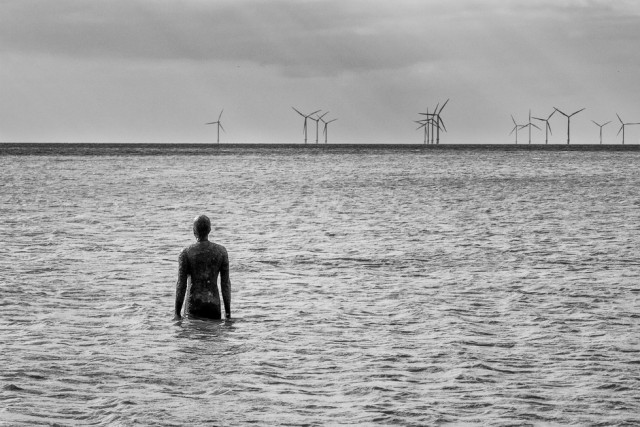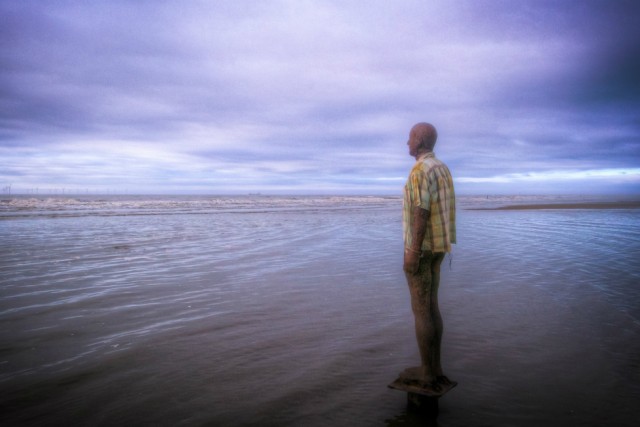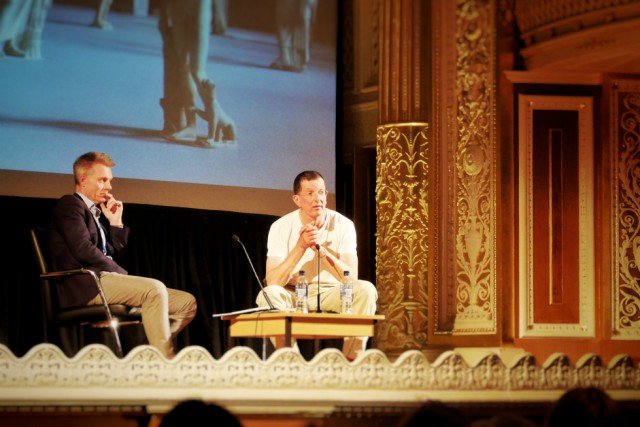Antony Gormley In Conversation: Iron Men At 10
As Another Place celebrate its 10th anniversary, Antony Gormley speaks out about “invading somebody else’s beach”, how public attitudes change, and his irritation with art history, finds Pete Goodbody…
We are here in the Concert Room at St George’s Hall to celebrate a birthday. In 2005, one hundred more or less identical cast-iron statues in the form of Antony Gormley were installed on Crosby Beach, Merseyside. 10 years on he’s back — to talk about the success and legacy of Another Place, and his take on art in general.
His interviewer is writer and broadcaster, Tim Marlow, who starts proceedings by having a little dig in his opening. “Good evening, Sir Antony”, he smiles — an apparently known irritant. It wouldn’t be the only one.
Marlow’s first question was probably the best in the sense it produced the best answer and set the theme for the evening: “How is it now?” Gormley said he got stuck in the quicksand the first time he visited Crosby Beach. But the figures are the things stuck now, not only in the sand but also in local people’s minds and memories. He disclaims it all as being “Not my work any more – it’s a part of the place”. The evolution of Another Place is something to be watched and, perhaps, better judged by future generations.
Of course, the statues were never intended to remain permanently in Merseyside; they were destined for New York in 2006, after previously being exhibited in Germany, Norway and Belgium. The installation was initially brought in by Liverpool Biennial and South Sefton Partnership. After some controversy from environmentalists and beach users, permission was eventually given for the work to remain by Sefton MBC. Gormley admits to “invading somebody else’s beach”.
But he also recognises and asserts art as a way of giving another dimension to life. It must engage in its own terms. Here again, he returns to the theme of art as a representation of time and place: “Another Place invites you to immerse yourself in time. There are 65 tonnes of material on the beach, but I don’t think of them as statues; they are turned to the horizon and as such they urge us to look the same way”.
They also change and develop over the seasons; regular visitors will know about the barnacles and the shifting sands. When Another Place was in Norway, one of them lost a nose due to the freezing temperatures. The nose wasn’t replaced.
Marlow suggests Gormley’s art has classical roots — the statues are a classic thing? This seems to irritate him a bit and he responds by a desire to “leave art history aside”. Human beings have always found it necessary to touch and make things for which words cannot easily be found. Otherwise, why was Stonehenge built? Gormley describes a need to make a place into an experience. That keeps his motivation on course. “I’m not that bothered about the trajectory of art history”.
The message from Gormley was about art as engagement, about affecting a place and / or a community as well as reacting to it. Experience is the key. And sticking with things.
There was a short audience Q & A after the discussion. One woman told Antony she had been challenged by her colleagues at work to get a selfie with him. He happily invited her onto the stage to do just that. A sense of place and time she won’t forget. But is it art?
Pete Goodbody
See Pete Goodbody’s tour of Gormley’s studio in London
Read more about Another Place through Liverpool Biennial and Antony Gormley’s website
All images courtesy Pete Goodbody








